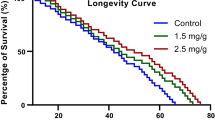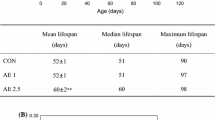Abstract
Curcumin, a bioactive polyphenolic compound in turmeric (Curcuma longa) rhizomes has been shown to exert anti-aging properties with limited scientific basis. Hence, this study sought to examine the antioxidant and anti-cholinesterase activities of curcumin-supplemented diets as well as their molecular effect on superoxide dismutase (SOD) and acetylcholinesterase (AChE) genes expression level associated with lifespan extension in Drosophila melanogaster model. In this experiment, D. melanogaster (both genders) of 1 to 3 days old were fed diets either containing no curcumin (control) or supplemented with curcumin at 0.2 and 1.0 mg/g of diet for 7 days. Subsequently, the survival and locomotor activities were determined. In addition, we evaluated RT-PCR expressions of SOD and AChE mRNA genes. Furthermore, catalase, SOD and AChE activities were determined. Curcumin-supplemented diet improves survival ability but did not affect locomotor activity when compared with the control. In addition, there was a significant increase in SOD and catalase with a concomitant decrease of AChE activities when compared with the control. Furthermore, curcumin-supplemented diets suppress AChE mRNA expression but no alteration on SOD gene expression level was observed when compared with control. In conclusion, our present results suggest that a down-regulation of AChE gene expression with a concomitant decrease of AChE activity as well as improving antioxidant status could be some possible mechanism in which curcumin exert anti-aging potential and increases lifespan of D. melanogaster.




Similar content being viewed by others
References
Caesar I, Jonson M, Nilsson KPR, Thor S, Hammarstrom P (2012) Curcumin Promotes A-beta Fibrillation and Reduces Neurotoxicity in Transgenic Drosophila. PLoS One 7(2):31424
Phom L, Achumi B, Alone DP, Muralidhara M, Yenisetti SC (2014) Curcumin’s Neuroprotective Efficacy in Drosophila Model of Idiopathic Parkinson’s Disease Is Phase Specific: Implication of its Therapeutic Effectiveness. Rejuvenation Res 17:481–489
Sarter M, Bruno JP (1998) Age-related changes in rodent cortical acetylcholine and cognition: main effects of age versus age as an intervening variable. Brain Res Rev 27:143–156
Valko M, Rhodes CJ, Moncol J, Izakovic M, Mazur M (2006) Free radicals, metals and antioxidants in oxidative stress induced cancer. Chem Biol Interact 160(1):1–40
Lee KS, Lee BS, Semnani S, Avanesian A, Um CY, Jeon HJ, Seong KM, Yu K, Min KJ, Jafari M (2010) Curcumin extends life span, improves health span and modulates the expression of age associated aging genes in Drosophila melanoasger. Rejuvenation Res 13:561–570
Taylor P, Radić Z (1994) The cholinesterases: from genes to proteins. Annu Rev Pharmacol Toxicol 34:281–320
Hai A, Kizilbash NA, Zaidi SH, Alruwaili J (2013) Porphyrin derivatives as inhibitors for acetylcholinesterase from Drosophila melanogaster. Bioinformation 9(12):645–649
Rossi L, Mazzitelli S, Arciello M, Capo CR, Rotilio G (2008) Benefits from dietary polyphenols for brain aging and Alzheimer's disease. Neurochem Res 33(12):2390–2400
Govindarajan VS (1980) Turmeric—chemistry, technology, and quality. Crc Crit Rev Food Sci Nutr 12(3):199–301
Sharma RA, Gescher AJ, Steward WP (2005) Curcumin: the story so far. Eur J Cancer 41(13):1955–1968
Salvioli S, Sikora E, Cooper EL, Franceschi C (2007) Curcumin in cell death processes: a challenge for CAM of age-related pathologies. Evid Based Complement Alternat Med 4(2):181–190
Sikora E, Bielak-Zmijewska A, Mosieniak G, Piwocka K (2010) The promise of slow down ageing may come from curcumin. Curr Pharm Des 16(7):884–892
Feany MB, Bender WW (2000) A Drosophila model of Parkinson's disease. Nature 404:394–398
Abolaji AO, Kamdem JP, Lugokenski TH, Farombi EO, Souza DO, daSilva LEL, Rocha JBT (2015) Ovotoxicants 4-vinylcyclohexene 1,2-monoepoxide and 4-vinylcyclohexene diepoxide disrupt redox status and modify different electrophile sensitive target enzymes and genes in Drosophila melanogaster. Redox Biol 5:328–339
Keseler IM, Collado-Vides J, Gama-Castro S, Ingraham J, Paley S, Paulsen IT, Peralta-Gil M, Karp PD (2005) EcoCyc: a comprehensive database resource for Escherichia coli. Nucleic Acids Res 1:334–337
Livak KJ, Schmittgen TD (2001) Analysis of relative gene expression data using real-time quantitative PCR and the 2(−deltadeltaC(T)) method. Methods 4:2001
Ellman GL, Courtney KD, Andres V Jr, Feathers-Stone RM (1961) A new and rapid colorimetric determination of acetylcholinesterase activity. Biochem Pharmacol 7:88–95
Elstner EF, Heupel A (1976) Inhibition of nitrite formation from hydroxylammoniumchloride: a simple assay for superoxide dismutase. Anal Biochem 70(2):616–620
Shen LR, Xiao F, Yuan P, Chen Y, Gao QK, Parnell LD, Meydani M, Ordovas JM, Li D, Lai CQ (2013) Curcumin-supplemented diets increase superoxide dismutase activity and mean lifespan in Drosophila melanoasger. Age 35:1133–1142
Valko M, Leibfritz D, Moncol J, Cronin MTD, Mazur M, Telser J (2007) Free radicals and antioxidants in normal physiological functions and human disease. Int J Biochem Cell Biol 39(1):44–84
Naidu KA, Thippeswamy NB (2002) Inhibition of human low density lipoprotein oxidation by active principles from spices. Mol Cell Biochem 229(1–2):19–23
Patro BS, Rele S, Chintalwar GJ, Chattopadhyay S, Adhikari S, Mukherjee T (2002) Protective activities of some phenolic 1,3-diketones against lipid peroxidation: possible involvement of the1,3-diketone moiety. Chembiochem 3(4):364–370
Sun J, Molitor J, Tower J (2004) Effects of simultaneous over-expression of Cu/ZnSOD and MnSOD on Drosophila melanogaster span. Mech Aging Dev 125:341–349
Suckow BK, Suckow MA (2006) Lifespan extension by the antioxidant curcumin in Drosophila. Int J Biomed Sci 2(4):401–404
Craig LA, Hong NS, McDonald RJ (2011) Revisiting the cholinergic hypothesis in the development of Alzheimer’s disease. Neurosci Biobehav Rev 35:1397–1409
Jones MA, Grotewiel M (2011) Drosophila as a model for age-related impairment in locomotor and other behaviors. Exp Gerontol 46:320–325
Zhang X, Lu L, Liu S, Ye W, Wu J, Zhang X (2013) Acetylcholinesterase deficiency decreases apoptosis in dopaminergic neurons in the neurotoxin model of Parkinson’s disease. Int J Biochem Cell Biol 45:265–272
Mythri RB, Srinivas Bharath MM (2012) Curcumin: a potential neuroprotective agent in Parkinson’s disease. Curr Pharm Des 18:91–99
Melo JB, Agostinho P, Oliveira CR (2003) Involvement of oxidative stress in the enhancement of acetylcholinesterase activity induced by amyloid beta-peptide. Neurosci Res 45:117–127
Haddadi M, Jahromi SR, Shivanandappa T, Ramesh S (2013) Decalepis hamiltonii Root Extract Attenuates the Age-Related Decline in the Cognitive Function in Drosophila melanogaster. Behav Brain Res 249:8–14
Haddadi M, Jahromi SR, Sagar BKC, Patil RK, Shivanandappa T, Ramesh SR (2014) Brain aging, memory impairment and oxidative stress: A study in Drosophila melanogaster. Behav Brain Res 259:60–69
Akhmedov K, Rizzo V, Kadakkuzha BM, Carter CJ, Magoski NS, Capo TR, Puthanveettil SV (2013) Decreased Response to Acetylcholine during Aging of Aplysia Neuron R15. PLoS One 8(12):84793
Acknowledgments
One of the authors (Ayodele Jacob Akinyemi) is a beneficiary of 2016 IBRO/ARC bursary award and wish to thank the organization for their support towards this study.
Author information
Authors and Affiliations
Corresponding author
Ethics declarations
Conflict of interest
No conflict of interest to be stated for any of the authors.
Rights and permissions
About this article
Cite this article
Akinyemi, A.J., Oboh, G., Ogunsuyi, O. et al. Curcumin-supplemented diets improve antioxidant enzymes and alter acetylcholinesterase genes expression level in Drosophila melanogaster model. Metab Brain Dis 33, 369–375 (2018). https://doi.org/10.1007/s11011-017-0100-7
Received:
Accepted:
Published:
Issue Date:
DOI: https://doi.org/10.1007/s11011-017-0100-7




